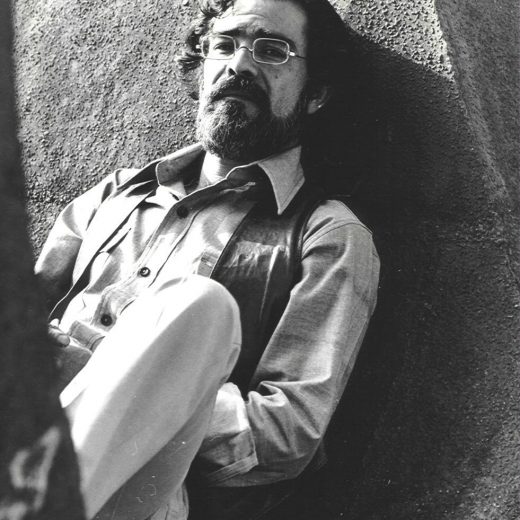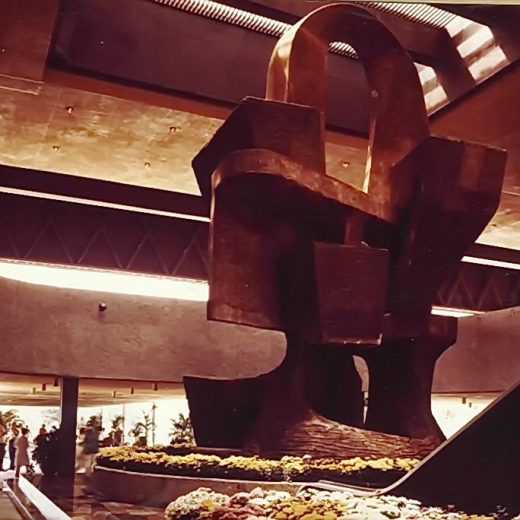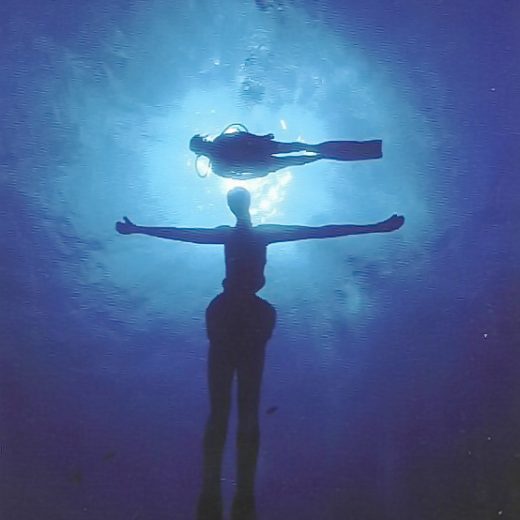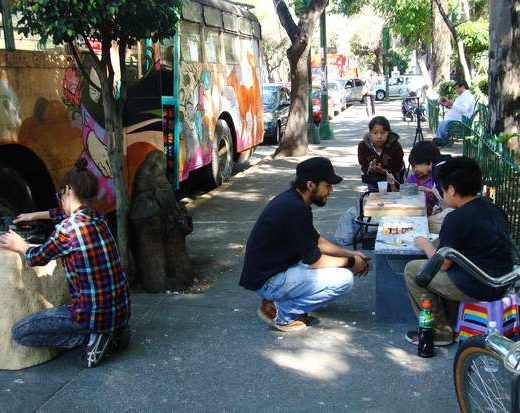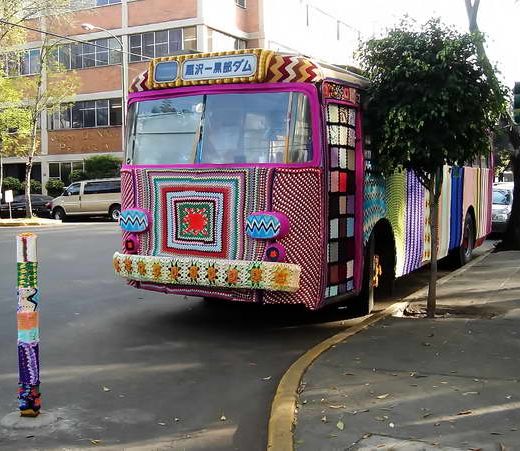News
Ode to a Squirrel
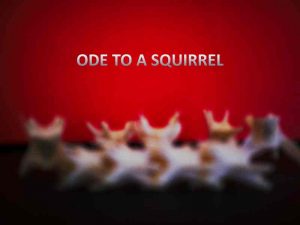
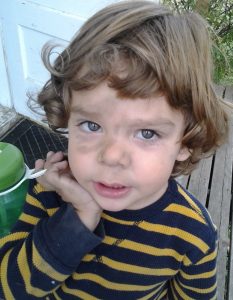 I found a note I wrote six ½ years ago describing how I found the spine of a squirrel that I am now using as a model for a sculpture I am currently working on. The story now makes me chuckle because I remember feeling completely unprepared to answer my son’s questions regarding the topic of death. He was only 3 ½ years old.
I found a note I wrote six ½ years ago describing how I found the spine of a squirrel that I am now using as a model for a sculpture I am currently working on. The story now makes me chuckle because I remember feeling completely unprepared to answer my son’s questions regarding the topic of death. He was only 3 ½ years old.
Death is a universal reality that preoccupies every individual on earth, and our first confrontation to the idea of mortality surely shapes the way we understand and experience our time on this earth. It is, after all, a big piece of the basic knowledge that we pass down to our kids. Looking back now, I realize that death awareness must go hand in hand with a developed sense of self. At the time I felt unprepared for a well-crafted answer, but now I believe that one of the most fascinating and rewarding aspects of being a mother is the opportunity to rediscover the world and review my real views and opinions about it. Here is the note of the adventure that introduced my son to the idea of mortality.
2013
A little over a month ago, while taking the usual break to collect our 3 1/2-year-old son from Montessori, we came across a dead squirrel that had been run over by a car. Our son stopped, looked at it for a while, and asked what was wrong with it and why it was not moving and acting like squirrels do. I told him the squirrel had been run over and died, and what he was looking at was no longer the squirrel. “If the squirrel isn’t there anymore, then where is it?” I said it had gone to where the moon, the sun and the stars lived. He seemed uncertain, and perhaps this answer will do for a while.
He seems to be more appreciative of squirrels and cautions them to beware of cars.
A few days later, while passing the same spot, I noticed that an animal, perhaps a crow or a magpie, had been pecking at the squirrel and its entire spine lay intact next to it.
Bones have been central to my work for many years now, and finding a good specimen is not an easy task, so a finding such as this is invaluable. I went to the studio for some tweezers and a bag and returned to collect my discovery; to clean it, number it and store it under the name ‘ode to a squirrel.’
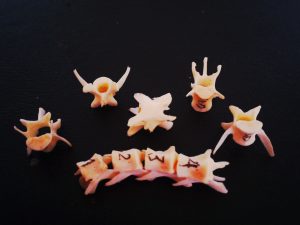
The Old Poplar Tree
When we first moved to Calgary, we rented a tiny old house in Bowness. In front of the house stood a majestic, beautiful, poplar tree that turned an intense yellow in the autumn and illuminated our evenings with a golden hue. We were there for a short time only, but never forgot the big old tree we nicknamed "our light."
Some years later, we passed by our old house when two men were cutting the poplar tree down. It brought us to tears, but there was nothing we could do. Stretched out on the lawn, in sections, lay the old tree. I approached the man with the chainsaw to tell him about our connection to the tree and asked him for the largest lumber pieces to take to the studio and carve.
At the time, I was working on the idea of making Atlas and Axis, but I still did not know what medium or materials I would use. Yet, when I stacked the lumber pieces on top of each other, I suddenly envisioned Atlas and Axis inside. I carved Atlas & Axis from the tree's wood as an homage to the warm light and shade it provided us. Throughout the process, I have tried to keep the tree's character intact without altering its knots, cracks or variation of colour.
A day in my Alma Mater
(Latin meaning of Alma Mater is nourishing or bountiful mother).
When Pipe invited me into his studio as an apprentice 24 years ago, he sealed, without knowing it, my path as an artist. I would drive to his home-studio located on the picturesque freeway from Cuernavaca to Mexico City in my black Vocho (Volkswagen Beetle). As agreed, I would meet him on the side of the road, and we would drive into his housing complex together. I will never forget the sight of him sitting there waiting for my arrival, elegantly poised on a rock, wearing his black Greek fisherman’s cap, and holding a cane with the head of a llama on it. His cane was a spade in disguise, and if someone complimented it, he would draw it in a flash to show off what was underneath and always enjoyed the shock in peoples faces. He lived alone in a quaint cabin with brick, hand-crafted dome roofs. Books lined the walls from floor to ceiling, yet, whenever he wanted to reference a book or lend me one to take home, he knew exactly where to go and look. In those days, he read voraciously and would tell me about the books that he was reading. He would recommend and lend books to me, and we would talk about them, laugh, and discuss.
I went to his studio daily for four years that were formative at every level, and of which I have fond memories. I honour those days every time I prepare a homemade release agent for moulds or a solution to harden plaster with alum stones, or make my own carnauba wax, or burnish a wooden sculpture with the secret technique he passed on to me. The other day, while looking for a carving tool in my drawer, I came across the set of rasps that he made for me and carved my name and date into. I remember when he gave them to me – I arrived at his studio that day to find a nicely wrapped present with a little card that read: “para Danira, del gran Pipe.” I still have that card. I cherish those rusty rasps and keep them like treasures in the same special little box where I keep a sculpting tool that I took from my school when I was in grade three. For some mysterious reason, I felt that that tool was indispensable for my 9-year-old persona, so I put it in my pocket and ran home as fast as I could.
I would arrive at his house by late morning. We would always begin the day with a cup of Cafe Oro, sitting in a little area in front of his front door, and talk about life, literature, art, or something from the day before that he wanted to re-evaluate. He was generous and thoughtful, and very appreciative of a great conversation which he liked to follow up with delightful gestures, like when we realized we shared a love of Oscar Wilde’s work. One day he surprised me with cucumber sandwiches prepared just like the ones Algernon ate in The Importance of Being Earnest.
In the evenings, or on cold, damp days, we would sit in his sunken living room with the fireplace going and classical music playing very loudly. He enjoyed the acoustic effect that the domes had on the sound. He would close his eyes and enjoy the music…. I remember Cesar Frank’s Sonata, among many more, and have a copy of it in my collection. The studio was a detached structure in the same compound with no heating, so It could get quite cold, damp, and foggy, making it impossible to work well with plaster, so we would go inside and have great conversations that he would reference with books and stories.
Pipe was one of these people that retained a youthful perspective on life and the way to live it that didn’t age, and he could connect to people of any age, but clearly preferred to communicate with the young. Even as his body aged his mind and general outlook on things stayed the same. He was an excellent listener to me and a wise and knowledgeable confidant. He had a witty and intelligent sense of humour but could, at times, be inflexible and arrogant.
Pipe is responsible for introducing me to the idea that I now refer to as constructible sculpture and the use of the combination of various materials. But more than that, I hold him responsible for being the defining element that pushed me to pursue sculpture professionally.
He passed away 10 years ago and today would have been his 86th birthday. These words are an homage to him. More to me than an uncle or a teacher, he was an accomplice with whom I had the joy and honour of sharing four edifying and beautiful years. Shortly before he died, he had dinner with us in our home in Mexico City. He had almost lost his voice entirely and spoke in a whisper. At some point over wine, he looked at Edward and me firmly and whispered… “Don’t forget that there will always be providence for the Artist.”
This is a conversation I would have liked to follow up on. We never did.
Poetics of Space
Sculpture Studio in Japanese Trolley, Mexico City
For a few years, we (Incipio Modo) worked from the interior of a Japanese trolley that we adapted as a sculpture studio. The trolley was parked in front of Plaza Luis Cabrera in the Roma district of Mexico City.
We worked in the public realm, both in the interior and exterior of the trolley, amongst the art galleries, cafes, fountains, shoemakers and street vendors. We were just another element in the streetscape and as such, we witnessed the City firsthand, while it pulsed with its daily activities, its familiar sounds, faces, and smells.
Our understanding of public space and place-making was shaped by this experience, and a desire to explore space physically and conceptually began to shape our practice. We began making public art soon after, and it has since become an important part of our artistic practice.
"There is this energy and aggression and speed in a city that lends itself to poetry"
~ Tom Chivers
Welcome to Incipio Modo
Welcome to our studio. We are two sculptors known as Incipio Modo, and through this blog you may follow the intricate process behind every work of art, in the place where it all happens: our Studio.
To learn a little more about the artists that form Incipio Modo, Danira Miralda and Edward Beltran, please visit the About Us page.
We focus our energies on several areas including Municipal projects, Corporate Commissions, Studio Work and Collaborative Projects with other artists. Please click the links above for more information on each area of focus.
Our website includes a Portfolio of some of our work including two major installations in the City of Calgary plus a variety of commissioned works. To view these works, select a project under Portfolio in the top navigation menu.
In addition, we have several completed works in our Studio Work section that we have decided to make available for purchase. These works range from diminutive pieces well suited for smaller spaces to substantial works well suited to larger areas. These works incorporate a wide variety of media and some unusual creative techniques. To view our currently available Studio Work, please Click Here.
Your involvement and feedback are encouraged and appreciated.
Thank You!
Danira & Edward
INCIPIO MODO



